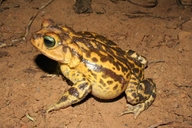|
Description
Bufo fustiger is a member of the Bufo peltocephalus group. These toads have brown, tan or chocolate brown dorsal surfaces with tan to yellow vermicular patterns. These patterns are diffuse and vary from wide to wormlike. While the dorsum is covered with low and rounded (but not spinose) tubercles, the dorsum of the head is uniformly brown. The venter is dull gray and also tuberculate. The limbs are banded, with the antebrachium, thigh, crus and pes each possessing two bands. The anterior and posterior faces of the thighs are light tan and mottled with brown blotches. Juveniles have gray-brown dorsal surfaces with two white dorsolateral stripes and some irregular, darker brown markings. The adult cranial crests are low. An anterorbital notch is present at junction of supraorbital and canthal crests. The irises are brilliant green. The upper lip is not flange-like; the chin and lower lip are cream-colored. The tympanum is large and the parotoid glands are enormous, placed diagonally behind the head casque. Adults are large, reaching lengths of 198 mm in females and 148 mm in males. It is the larger of the Antillean toads (Schwartz 1960; Ruiz 1987; Valdes 1989; Schwartz and Henderson 1991).
Distribution and Habitat
Country distribution from AmphibiaWeb's database: Cuba
This species is endemic to Cuba and is found in the western part of the island, from Pinar del Río to Matanzas provinces. It is found in broadleaf forests, cultivated fields, along stream banks and around rural houses (Schwartz 1960; Schwartz and Henderson 1991).
Life History, Abundance, Activity, and Special Behaviors
Bufo fustiger is a nocturnal toad, taking refuge by day between and under rocks and palm trunks. Males vocalize from the ground while positioned among the roots of riparian vegetation. They form loud choruses on the shoreline of mountain streams and other bodies of water. Breeding males have nuptial excrescences on their thumbs. The amplexus is axillary. The eggs are laid in double strings with each egg measuring about 2 mm in diameter. Calls consist of periodic notes containing two or three amplitude modulations. The dominant frequency is around 0.7 kHz. These calls are like a “coc, cloc, croc, croc, co-croc, co-croc, co-croc,” with the beginning notes shorter and the terminal notes more rapid. Food includes beetles and other insects, slugs, scorpions (Rhopalurus junceus), vinegaroons (Mastigoproctus sp.) and vegetal matter. It is able to inflate itself to prevent ingestion by predators (Schwartz 1960; Armas 1987; Ruiz 1987; Valdes 1989; Schwartz and Henderson 1991; Alonso and Rodriguez 2003). Possible reasons for amphibian decline General habitat alteration and loss
Intensified agriculture or grazing
Comments
Synonyms: Peltaphryne peltocephalus fustiger (Schwartz 1960), Peltaphryne fustiger (Schwartz 1960)
Related species: B. peltocephalus, B. taladai
References
Alonso, R., and Rodríguez, A. (2003). ''Advertisement calls of Cuban toads of the genus Bufo (Anura, Bufonidae).'' Phyllomedusa, 2(2), 75-82.
Armas, L.F. (1987). ''Depredación de arácnidos por dos vertebrados cubanos.'' The Zoological Miscellany, 34, 1-2.
Collins, J. T. (1993). Amphibians and Reptiles in Kansas: Third Edition, revised. University of Kansas Museum of Natural History, Lawrence.
Ruiz, F. N. (1987). Anfibios de Cuba. Cientifíco-Técnica, La Habana.
Schwartz, A . and Henderson, R. W. (1985). A Guide to the Identification of the Amphibians and Reptiles of the West Indies Exclusive of Hispaniola. Milwaukee Public Museum, Milwaukee.
Schwartz, A. (1960). ''The large toads of Cuba.'' Proceedings of the Biological Society of Washington, 73, 45-56.
Schwartz, A. and Henderson, R. W. (1991). Amphibians and Reptiles of the West Indies: Descriptions, Distributions and Natural History. University Press of Florida, Florida.
Valdés, A. (1989). ''Systematics comments on Peltophryne peltocephala (Anura: Bufonidae) in the Cuban Archipelago.'' Caribbean Journal of Science, 24(1-2), 39-43.
Originally submitted by: Ansel Fong G. (first posted 2004-10-04)
Edited by: Anisha Ghandi (2008-02-03)Species Account Citation: AmphibiaWeb 2008 Peltophryne fustiger: Western Cuba Giant Toad <https://amphibiaweb.org/species/6045> University of California, Berkeley, CA, USA. Accessed Dec 16, 2024.
Feedback or comments about this page.
Citation: AmphibiaWeb. 2024. <https://amphibiaweb.org> University of California, Berkeley, CA, USA. Accessed 16 Dec 2024.
AmphibiaWeb's policy on data use.
|
